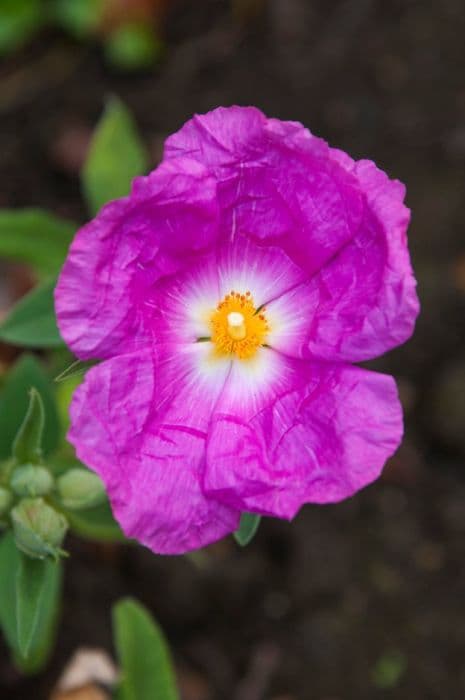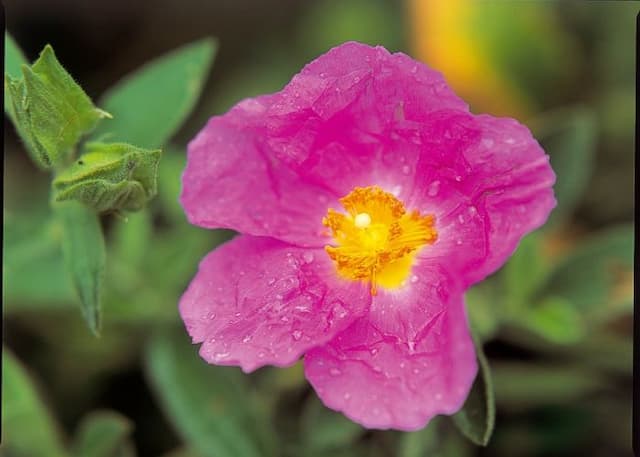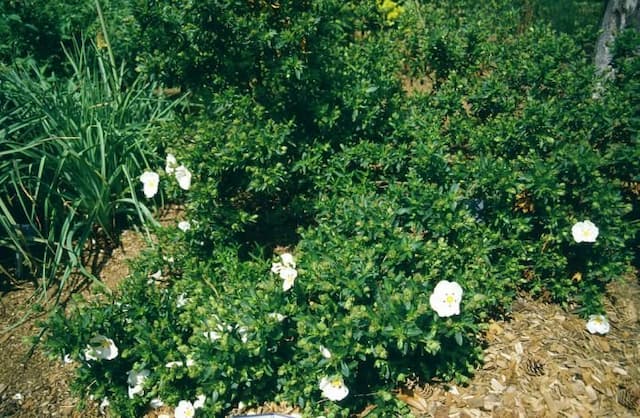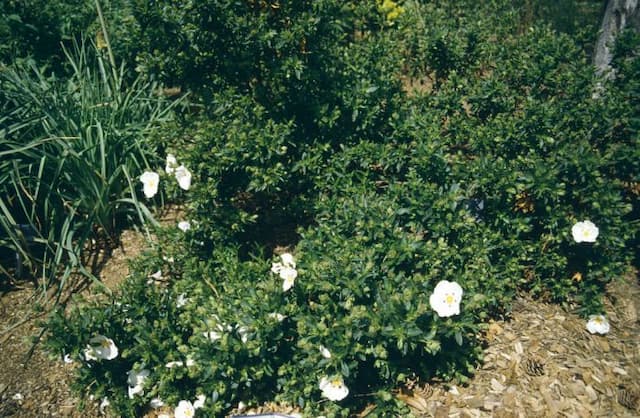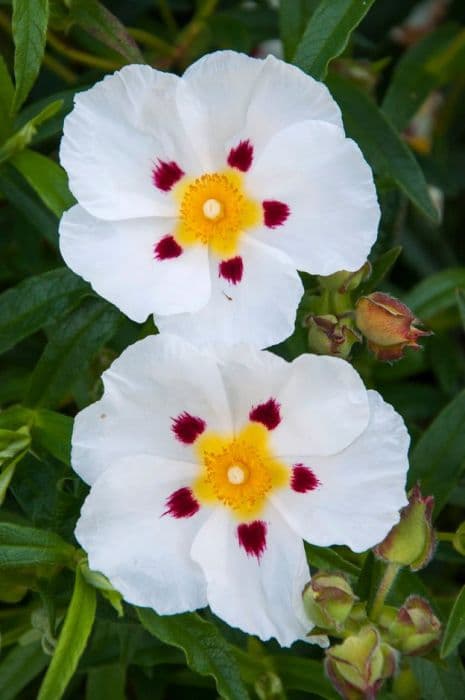Rock Rose × Halimiocistus sahucii

ABOUT
× Halimiocistus sahucii, commonly known as the Sahuc's rockrose, is a hybrid garden plant known for its distinctive appearance. The Sahuc's rockrose features evergreen foliage, meaning it retains its leaves throughout the year, providing a constant display of greenery. Its leaves are small, narrow, and a deep, glossy green, which contrast beautifully with the flower colors. The standout feature of Sahuc's rockrose is its flowers. These blossoms are showy and cup-shaped with a very distinctive coloring pattern. Typically, the petals are white, providing a luminous quality that can brighten up any garden. At the base of each petal, you may observe a striking splash of yellow, giving the appearance of a sunburst that adds depth and character to the floral display. These flowers are not only attractive but also have a pleasant fragrance. This scent can make Sahuc's rockrose an excellent choice for planting in areas where people can enjoy not just the visual appeal but also the aromatic experience. Sahuc's rockrose has a bushy and spreading nature; it grows in a mounded form, which adds to its ornamental value. This rounded shape allows it to fill spaces in the landscape with its dense foliage, and the flowers, when in bloom, create an eye-catching feature amidst the greenery. Overall, Sahuc's rockrose is a plant with a picturesque appearance, combining attractive green foliage with delightful, fragrant flowers that exhibit a noteworthy contrast of colors. Its evergreen nature ensures that it provides year-round interest, making it a valuable addition to any space that can accommodate its growth habit.
About this plant
 Names
NamesFamily
Cistaceae.
Synonyms
Sahuc's Rockrose.
Common names
× Halimiocistus sahucii.
 Toxicity
ToxicityTo humans
× Halimiocistus sahucii, commonly known as the Sahuc rockrose, is not widely recognized for toxicity to humans. There is limited information available on the toxicity of this specific hybrid. However, as with any plant, it's generally advisable to avoid ingesting parts of unknown plants due to potential risks including allergic reactions or gastrointestinal discomfort. If you suspect poisoning from any plant, seeking medical attention is recommended.
To pets
The Sahuc rockrose (× Halimiocistus sahucii) does not have well-documented toxicity for pets either. However, similar to humans, the lack of information makes it wise to prevent pets from ingesting this or any plant of uncertain edibility. Ingestion may cause mild to moderate gastrointestinal upset or an allergic reaction. If you observe any signs of distress, pain, vomiting, or diarrhea in your pet after ingestion, contact a veterinarian.
 Characteristics
CharacteristicsLife cycle
Perennials
Foliage type
Evergreen
Color of leaves
Green
Flower color
White
Height
3 feet [91 cm]
Spread
5 feet [152 cm]
Plant type
Shrub
Hardiness zones
8
Native area
Hybrid
Benefits
 General Benefits
General Benefits- Low Maintenance: Requires minimal care once established, making it ideal for gardeners of all skill levels.
- Drought Tolerance: Can survive with little water, suited to arid climates or water-wise gardens.
- Attracts Pollinators: Flowers attract bees and other beneficial insects, supporting local ecosystems.
- Ornamental Value: Offers aesthetic appeal with its vibrant flowers, enhancing the visual beauty of gardens and landscapes.
- Erosion Control: Its roots help stabilize soil and prevent erosion in sloped areas.
- Hardiness: Resilient against various climatic conditions, capable of surviving in a range of temperatures and environments.
- Long Blooming: Produces flowers for an extended period, providing color in the garden for much of the year.
 Medical Properties
Medical PropertiesThis plant is not used for medical purposes.
 Air-purifying Qualities
Air-purifying QualitiesThis plant is not specifically known for air purifying qualities.
 Other Uses
Other Uses- Garden Erosion Control: The plant’s dense growth can help stabilize soil on slopes and prevent erosion.
- Wildlife Shelter: Provides shelter for small animals and insects within a garden ecosystem.
- Bonsai Specimen: Enthusiasts may use this plant for creating bonsai due to its interesting form and foliage.
- Natural Dye: Parts of the plant might be used to produce natural dyes for textiles.
- Landscape Design: Its silver-green foliage and white flowers are used to add contrast in garden designs.
- Crafts and Arrangements: Dried branches can be used in floral arrangements or crafts.
- Ground Cover: It can serve as a ground cover in wide spaces due to its spreading habit.
- Thematic Gardens: Can be used in Mediterranean or drought-resistant garden themes.
- Photography: It may serve as an attractive subject for garden and plant photography due to its flowers.
- Education and Research: Used in botanical studies to educate about plant hybridization and adaptation.
Interesting Facts
 Feng Shui
Feng ShuiHalimiocistus sahucii is not used in Feng Shui practice.
 Zodiac Sign Compitability
Zodiac Sign CompitabilityHalimiocistus sahucii is not used in astrology practice.
 Plant Symbolism
Plant SymbolismUnfortunately, × Halimiocistus sahucii, commonly known as Sahuc's rockrose, does not have a well-documented symbolic meaning as it is a relatively obscure hybrid plant and not widely recognized in the world of plant symbolism. Standard plant symbolism usually covers more commonly known species and those with a long history of human interaction. Therefore, I cannot provide a list of symbolic meanings for × Halimiocistus sahucii.
 Water
WaterThe Rock Rose should be watered moderately during its growing season, which typically spans from spring to summer. Soil should be allowed to dry out somewhat between waterings, with more thorough watering required every one to two weeks, depending on weather conditions. Provide approximately 1 to 2 gallons of water to ensure the root zone is sufficiently moistened, but be careful not to overwater as the Rock Rose prefers well-draining soil and can be prone to root rot if left in soggy conditions.
 Light
LightThe Rock Rose thrives best in full sunlight which helps the plant to develop its full potential in terms of growth and flower production. It's ideal to choose a spot where the plant can receive at least six hours of direct sunlight daily. If grown indoors, a south-facing window would be the most suitable spot, ensuring the plant gets enough light.
 Temperature
TemperatureThe Rock Rose prefers temperatures between 50 to 86 degrees Fahrenheit for optimal growth. It can endure dips down to about 30 degrees Fahrenheit but should be protected from frost. Maintaining temperatures within this range will ensure healthy growth and flowering.
 Pruning
PruningPruning the Rock Rose is important to maintain its shape and encourage bushier growth. Prune lightly after the blooming period in late summer or early fall, removing spent flowers and any leggy or dead branches. This can be done annually to help regenerate the plant and keep it looking its best.
 Cleaning
CleaningAs needed
 Soil
SoilThe best soil mix for the × Halimiocistus sahucii, commonly known as Rock Rose, should be well-draining, with a mixture of loam, sand, and peat to mimic its natural habitat. The ideal soil pH for Rock Rose ranges from slightly acidic to neutral, around 6.0 to 7.5.
 Repotting
RepottingRock Rose should be repotted every 2 to 3 years or when it has outgrown its current container. It's essential to use fresh, well-draining soil mix when repotting to ensure the roots remain healthy.
 Humidity & Misting
Humidity & MistingRock Rose prefers a Mediterranean climate, thus it is best suited to low to moderate humidity levels. Excessive humidity can lead to fungal problems, so ensuring good air circulation around the plant is important.
 Suitable locations
Suitable locationsIndoor
Place in a sunny spot and water sparingly.
Outdoor
Plant in full sun, protect from harsh winter.
Hardiness zone
8-11 USDA
 Life cycle
Life cycle× Halimiocistus sahucii, commonly known as the Sahuc Rockrose, begins its life cycle with seed germination, which occurs in well-drained, gritty soil under full sun, requiring some warmth. Seedlings develop into young plants showcasing woolly, evergreen foliage that forms a shrubby growth habit. As the plant matures, it enters a vegetative state, where it focuses on leaf and stem development to form a sturdy structure. During spring to early summer, the Sahuc Rockrose reaches its reproductive stage, producing white flowers with yellow centers that are pollinated by insects, leading to the formation of seed pods. After pollination and seed set, the plant enters a period of dormancy during hotter or colder seasons, conserving energy. With the onset of favorable conditions, the cycle repeats when the seeds from the pods germinate to begin the next generation of plants.
 Propogation
PropogationPropogation time
Spring-summer
× Halimiocistus sahucii, commonly known as the rock rose, is most commonly propagated through semi-hardwood cuttings. During the late summer, a gardener might select healthy, semi-ripe stems and prepare cuttings about 4 to 6 inches (10 to 15 cm) long. Leaves at the lower third of the cutting are removed, and the base is often dipped in a rooting hormone to increase the chances of successful rooting. The cuttings should then be inserted into a well-draining propagation medium. A high humidity environment is beneficial for root development, which can sometimes be achieved by covering the cuttings with a plastic bag to retain moisture. It typically takes a few weeks for roots to establish, after which the new rock rose plants can be transferred to individual pots or their final location in the garden.
